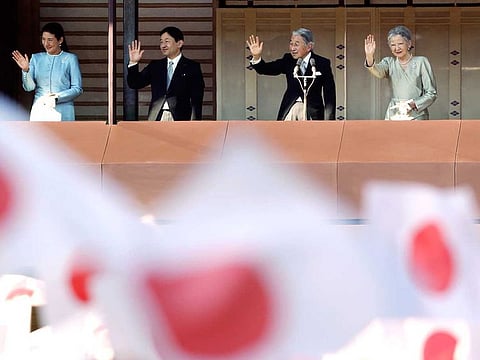Japan's Emperor Akihito Steps Down: A Life in Pictures
Crown Prince Naruhito will ascend the Chrysanthemum Throne after his father abdicates

(Bloomberg) - Japanese Emperor Akihito, 85, is ending his three-decade reign on April 30, voluntarily stepping down due to health concerns. It is the country's first abdication of the Chrysanthemum Throne since 1817.
His 31-year imperial era "- known as Heisei, which can be translated as "achieving peace" "- comes to an end with a ceremony at the Imperial Palace in Tokyo. A day after the abdication, his son, Crown Prince Naruhito, 59, ascends the throne in ceremonies at the same location.
Akihito helped to modernize the world's oldest hereditary monarchy by bringing the imperial family closer to the public. He and his wife, Empress Michiko, have taken on gentle public personas and were seen as helping the nation through catastrophic natural disasters with displays of compassion that included visits to evacuation centers to speak to survivors.
His landmark apologies for the wartime aggression launched in the name of his father, Hirohito, helped ease often fraught relations with neighbors China and South Korea, which bore heavy blows from Japan's militarism. Akihito spoke in ordinary Japanese, rather than the formal grammar employed by his father, the last emperor regarded by prevailing custom to be a living deity.
Akihito is an emperor of firsts. He was the first emperor to reign entirely under the U.S.-drafted pacifist constitution after World War II, the first to marry a commoner and, along with his wife, the first to raise his children at home.
The public reacted sympathetically when he made a rare televised address in 2016 telling of his intention to abdicate "- citing his advanced age and poor health. The government then passed a special one-time law to allow for him to step down.
The emperor and empress have made official visits to 28 countries, according to the Imperial Household Agency.
Then-Prince Akihito is pictured at the ceremony where he was formally proclaimed successor to the Chrysanthemum Throne in Tokyo in November 1952.
Crown Prince Akihito and Crown Princess Michiko at the Tokyo Lawn Tennis Club. The emperor and empress met on the court and their whirlwind courtship helped to set off a tennis boom in Japan.
In 1959, Crown Prince Akihito marries Princess Michiko. Along with parades through the streets, they also had a formal moment with Emperor Hirohito and Empress Nagako at the Imperial Palace.
Akihito and Michiko play greater roles in parenting, redefining the role of the imperial family.
Like his father, Naruhito represents Japan during visits by foreign dignitaries.
New Emperor Akihito makes formal comments during his enthronement ceremony at the Imperial Palace in 1990, several months after his father Hirohito's death.
In October 1992, Akihito becomes the first Japanese emperor to visit China.
Crown Prince Naruhito of Japan and his future wife Masako Owada, a former diplomat, appear in traditional Japanese costume prior to their wedding in 1993.
Akihito keeps close ties with Britain's monarchs. He walks between ranks of soldiers as he inspects a guard of honor at the start of his five-day U.K. state visit in 1998, where he met Queen Elizabeth.
Yoshihide Suga, Japan's chief cabinet secretary, unveils the name of the next imperial era "- "Reiwa" "- at the prime minister's official residence a month before the ascension of Naruhito. On the streets of Tokyo, people scramble to collect copies of an extra edition of the Asahi Shimbun newspaper reporting on the announcement of the new name.
In his final weeks in office, Emperor Akihito visits shrines central to the imperial family center. Here, Imperial Household Agency officials carry two of the "Three Sacred Treasures of Japan" at the Ise Jingu shrine.
The treasures are the Imperial Regalia of Japan, which are said to have been handed down through the generations and include a sacred mirror, sword and jewels. Naruhito's inheritance of the treasures will serve as a proof of ascension to the throne.
Sign up for the Daily Briefing
Get the latest news and updates straight to your inbox



